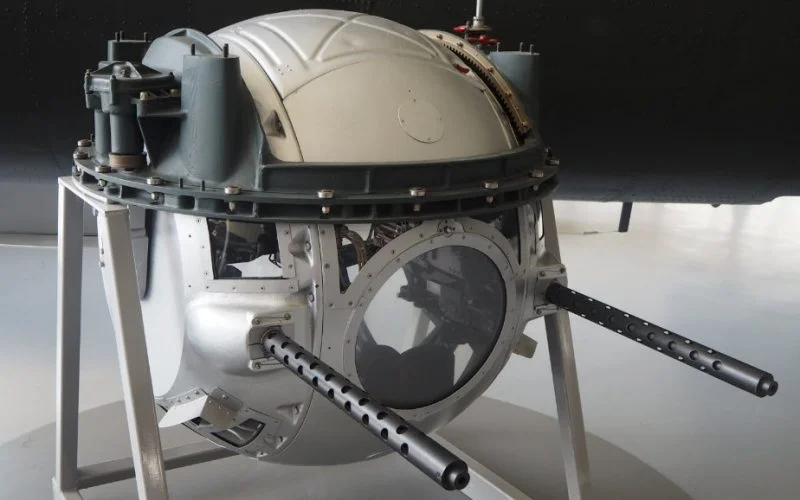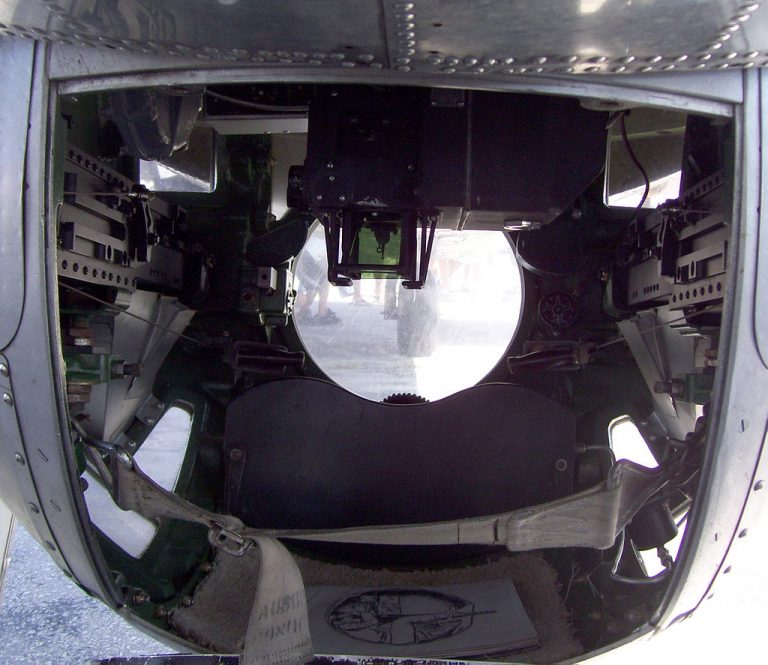
WWII
The Ball Turret – a Vertigo Sufferer’s Nightmare
A bomber’s ball turret position is often looked at with fear. Suspended underneath a bomber, it’s the only thing separating you from a 30,000 feet drop. The turret was a small, cramped place to be, often operated by the smallest men available.
From this position a gunner could cover virtually the entire underside of the aircraft with his machine guns.
It was named the Sperry turret, after the company that made them; the Sperry Corporation.
They were most famously used on the Boeing B-17 Flying Fortress, but also saw use on the B-24 Liberator bomber.
 The ball turret on a B-17G. Image by JustSomePics CC BY-SA 4.0
The ball turret on a B-17G. Image by JustSomePics CC BY-SA 4.0
The Ball Turret’s Origin
Despite the strong association with the aircraft, the B-17 was not originally designed with a ball turret. Early models had very different defensive setup.
B-17 models A and B had blister canopies on the waist section of the fuselage armed with machine guns. The underside was protected by another blister with a single machine gun.
The waist blisters were a poor design that caused considerable drag, disturbed airflow, and limited the gunners’ traverse. These were removed in the B-17C and replaced with flush windows.
 An early B-17C. Note the ‘bathtub’ gunner position under the aircraft.
An early B-17C. Note the ‘bathtub’ gunner position under the aircraft.
The B-17C also changed the belly position to a ‘bath tub’ style, similar to the German Heinkel 111. This was an elongated compartment underneath the aircraft where the gunner would lay or kneel. From here, the gunner could protect the rear section below the plane.
In the 1941 B-17E model, the tub was replaced with the famous ball turret. It was able to turn on two axis; 360 degrees horizontally and 90 degrees vertically. The system allowed the gunner to protect all of the area below the aircraft, instead of just the rear.
How it Worked
The turret was attached to a strong support beam that ran along the top of the aircraft’s fuselage. Its movement was controlled by a self-contained, electrically-powered hydraulic system, and could rotate at high speeds – important for tracking fast-moving enemy aircraft.
It moved horizontally by a ring gear on the turret. A trunnion system provided vertical movement. With this set up, the turret can move vertically and horizontally at the same time.
 The turret outside the aircraft showing the ring gear.
The turret outside the aircraft showing the ring gear.
Entering the Turret
The ball’s door was located directly behind the gunner, so with the guns at 0 degrees of elevation the turret could technically be entered from the outside while the B-17 was on the ground.
However, since there was only 40 cm between the ball and the runway, gunners would wait until the aircraft was in flight before entering. This was the same for the return flight.
B-24 Liberators were too low to the ground for the ball to fit, so they were fitted with a retractable turret that was stowed away for take off and landing.
 The door of the ball turret can be seen from above, inside the aircraft. Image by The PIPE CC BY-SA 4.0
The door of the ball turret can be seen from above, inside the aircraft. Image by The PIPE CC BY-SA 4.0
To enter in flight, the gunner had to manually traverse the turret so the guns were pointing directly down, which provided access to the door at the rear of the turret.
Once in, the door was closed shut, and he placed his feet into stirrups in front of him, holding the triggers above his head. His position resembled the fetal position. On the ends of the grips were the buttons to fire the guns.
Operating the Turret
The gunner looked through a central window between the guns to aim. He was shielded by an armour plate in front of him. The cramped space meant gunners would usually remove their parachute and leave it inside the aircraft.
 Ball turret training simulator mounted on the back of a truck.
Ball turret training simulator mounted on the back of a truck.
For defence, two Browning AN/M2 .50 calibre machine guns were squeezed into the turret either side of the gunner. This provided some incredible firepower in a small space. The AN/M2 guns were lightened versions of the ground based M2 machine gun, with a rate of fire of 600-800 rounds per minute each.
To aim the guns, the Sperry turrets were equipped with the advanced K-4 gun sight. It was mounted above and in front of the gunner’s head, so its reticule would be in line with his eyes. The K-4 sight worked by using data inputs from the gunner to calculate the required deflection (lead).
 The small size of the turret is apparent here.
The small size of the turret is apparent here.
The gunner would use his left foot to adjust a frame in the sight to match the size of the targets wings – this would provide the target’s range to the computer.
Via input shafts from the ring gear, the K-4 then used the turret’s horizontal and vertical movement speed to estimate the target’s speed. With this information, the site’s reticule would automatically adjust to the lead required to hit the target.
For 1941 this was cutting edge technology.
 The cramped space and K-4 sight can be seen from this view inside. Image by Mr.Z-man CC BY-SA 3.0
The cramped space and K-4 sight can be seen from this view inside. Image by Mr.Z-man CC BY-SA 3.0
Bomber Crews
As with all roles in the B-17, the ball turret gunner needed to be fearless. He can look out of his porthole straight down for almost six miles, while battling incoming aircraft, sealed inside an aluminium ball without a parachute.
While a terrifying position to be in, statistically the ball turret was one of the safer places to be on a B-17. The compact size of the gunner surrounded by thick glass, aluminium and armour plating, combined with being underneath the aircraft, meant the gunner was relatively safe.
 An experimental US ball turret that contains four .50 caliber machine guns, rather than the typical two. It is the Sperry Gyro 151, and very little is known about it.
An experimental US ball turret that contains four .50 caliber machine guns, rather than the typical two. It is the Sperry Gyro 151, and very little is known about it.
This however quickly flips when the aircraft is shot down, as the gunner has to turn to the turret to the exit position, climb out and put on his parachute, all while the aircraft is falling out the sky.
Ball turrets were eventually abandoned in later aircraft in favour of remote controlled systems, and then radar aimed turrets in aircraft like the B-52. The last aircraft shot down by a defensive gunner was in 1972, where a B-52 tail gunner destroyed a MIG-21 over Vietnam.
Who Invented the Ball Turret?
Though both Sperry Corporation and Emerson Electric designed ball turrets, the latter stopped before they could fully develop them. Sperry designed the turret to fit under bombers. From there, a gunner could defend the plane 360° directions with its two machine guns. To protect the gunner, the turret was covered in armor plate.
News
The Hanging Temple: China’s 1,500-Year-Old Cliffside Marvel of Faith and Engineering
The Hanging Temple: China’s 1,500-Year-Old Cliffside Marvel of Faith and Engineering Perched precariously on the cliffs of Mount Heng in Shanxi Province, China, the Hanging Temple, also known as Xuankong Temple, Hengshan Hanging Temple, or Hanging Monastery, is an architectural…
The Willendorf Venus: A 30,000-Year-Old Masterpiece Reveals Astonishing Secrets
The Willendorf Venus: A 30,000-Year-Old Masterpiece Reveals Astonishing Secrets The “Willendorf Venus” stands as one of the most revered archaeological treasures from the Upper Paleolithic era. Discovered in 1908 by scientist Johann Veran near Willendorf, Austria, this small yet profound…
Unveiling the Maya: Hallucinogens and Rituals Beneath the Yucatán Ball Courts
Unveiling the Maya: Hallucinogens and Rituals Beneath the Yucatán Ball Courts New archaeological research has uncovered intriguing insights into the ritual practices of the ancient Maya civilization. The focus of this study is a ceremonial offering found beneath the sediment…
Uncovering the Oldest Agricultural Machine: The Threshing Sledge’s Neolithic Origins
Uncovering the Oldest Agricultural Machine: The Threshing Sledge’s Neolithic Origins The history of agricultural innovation is a fascinating journey that spans thousands of years, and one of the earliest known agricultural machines is the threshing sledge. Recently, a groundbreaking study…
Nara’s Ancient Sword: A 1,600-Year-Old Protector Against Evil Spirits
Nara’s Ancient Sword: A 1,600-Year-Old Protector Against Evil Spirits In a remarkable discovery that has captured the attention of archaeologists and historians alike, a 7.5-foot-long iron sword was unearthed from a 1,600-year-old burial mound in Nara, Japan. This oversized weapon,…
The Inflatable Plane, Dropped Behind the Lines for Downed Pilots
Experimental The Inflatable Plane, Dropped Behind the Lines for Downed Pilots The Inflatoplane from Goodyear was an unconventional aircraft developed by the Goodyear Aircraft Company, a branch of the renowned Goodyear Tire and Rubber Company, also famed for the Goodyear…
End of content
No more pages to load











